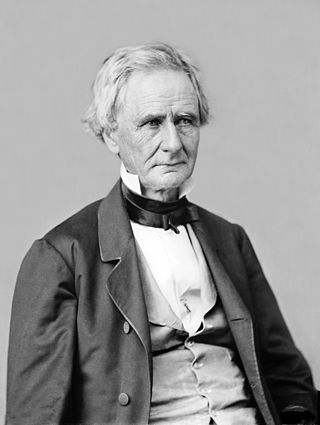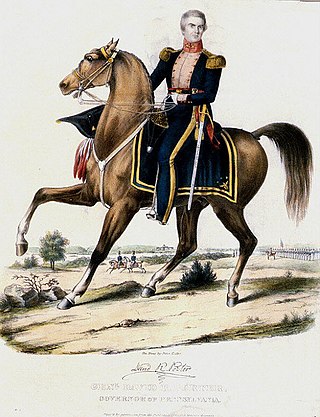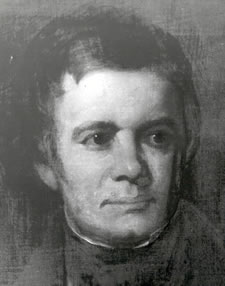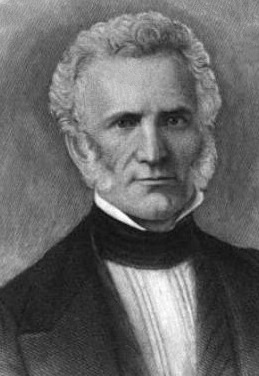Related Research Articles
The Anti-Masonic Party was the earliest third party in the United States. Formally a single-issue party, it strongly opposed Freemasonry in the United States. It was active from the late 1820s, especially in the Northeast, and later attempted to become a major party by expanding its platform to take positions on other issues. It declined quickly after 1832 as most members joined the new Whig Party; it disappeared after 1838.

Presidential elections were held in the United States from November 3 to December 7, 1836. Incumbent Vice President Martin Van Buren, candidate of the Democratic Party, defeated four candidates fielded by the nascent Whig Party.

Presidential elections were held in the United States on November 7, 1848. Held in the aftermath of the Mexican–American War, General Zachary Taylor of the Whig Party defeated Senator Lewis Cass of the Democratic Party.

Presidential elections were held in the United States on November 4, 1856. Democratic nominee James Buchanan defeated Republican nominee John C. Frémont and Know Nothing/Whig nominee Millard Fillmore. The main issue was the expansion of slavery as facilitated by the Kansas–Nebraska Act of 1854. Buchanan defeated President Franklin Pierce at the 1856 Democratic National Convention for the nomination. Pierce had become widely unpopular in the North because of his support for the pro-slavery faction in the ongoing civil war in territorial Kansas, and Buchanan, a former Secretary of State, had avoided the divisive debates over the Kansas–Nebraska Act by being in Europe as the Ambassador to the United Kingdom.

Simon Cameron was an American businessman and politician who represented Pennsylvania in the United States Senate and served as United States Secretary of War under President Abraham Lincoln at the start of the American Civil War.
Joseph Ritner was the eighth governor of Pennsylvania, and was a member of the Anti-Masonic Party. Elected governor during the 1835 Pennsylvania gubernatorial election, he served from 1835 to 1839.

David Rittenhouse Porter was the ninth governor of Pennsylvania. Voted into office during the controversial 1838 Pennsylvania gubernatorial election, which was characterized by intense anti-Masonic and anti-abolitionist rhetoric during and after the contest that sparked the post-election Buckshot War, he served as the state's chief executive officer from 1839 to 1845.

William Fisher Packer was an American politician from Pennsylvania who served as the 14th governor of Pennsylvania from 1858 to 1861.

Samuel Jackson Randall was an American politician from Pennsylvania who represented the Queen Village, Society Hill, and Northern Liberties neighborhoods of Philadelphia from 1863 to 1890 and served as the 44th speaker of the United States House of Representatives from 1876 to 1881. He was a contender for the Democratic Party nomination for President of the United States in 1880 and 1884.
John Strohm was an American politician from Pennsylvania who served as a Whig member of the U.S. House of Representatives for Pennsylvania's 8th congressional district from 1845 to 1849.

The 1850–51 United States Senate elections were held on various dates in various states. As these U.S. Senate elections were prior to the ratification of the Seventeenth Amendment in 1913, senators were chosen by state legislatures. Senators were elected over a wide range of time throughout 1850 and 1851, and a seat may have been filled months late or remained vacant due to legislative deadlock. In these elections, terms were up for the senators in Class 1.

The 1840–41 United States Senate elections were held on various dates in various states. As these U.S. Senate elections were prior to the ratification of the Seventeenth Amendment in 1913, senators were chosen by state legislatures. Senators were elected over a wide range of time throughout 1840 and 1841, and a seat may have been filled months late or remained vacant due to legislative deadlock. In these elections, terms were up for the senators in Class 2.

The 1838 Pennsylvania gubernatorial election was a statewide contest for the office of Governor of the Commonwealth of Pennsylvania in the United States.

The 1860–61 United States Senate elections were held on various dates in various states. As these U.S. Senate elections were prior to the ratification of the Seventeenth Amendment in 1913, senators were chosen by state legislatures. Senators were elected over a wide range of time throughout 1860 and 1861, and a seat may have been filled months late or remained vacant due to legislative deadlock. In these elections, terms were up for the senators in Class 3.

The history of the United States Congress refers to the chronological record of the United States Congress including legislative sessions from 1789 to the present day. It also includes a brief history of the Continental Congress from 1774 through 1781 and the Congress of the Confederation from 1781 to 1789.

Charles Bingham Penrose was an American politician who served as a Democratic-Republican and Whig member of the Pennsylvania Senate for the 16th and 14th district from 1833 to 1841 and as a Republican member for the 1st district in 1857. He served as Speaker of the Pennsylvania Senate from 1838 to 1839 and again in 1841. He was a key figure during the Buckshot War unrest in Harrisburg, Pennsylvania, after the 1838 legislative election, when both Whigs and Democrats claimed control over the Pennsylvania House of Representatives.

The 1840 United States Senate election in Pennsylvania was held on January 14, 1840, after the regularly scheduled election in December 1838 was postponed due to the Buckshot War. Daniel Sturgeon was elected by the Pennsylvania General Assembly to the United States Senate.

On January 15, 1867, Simon Cameron was elected to the United States Senate by the Pennsylvania General Assembly for the third time; it had previously chosen him in 1845 and 1857. The legislature voted for Cameron over the incumbent, Senator Edgar Cowan, who, though a Republican, was endorsed by the Democratic legislative caucus. With the Republican Party holding a large majority in the legislature, the main battle was for its endorsement: the caucus of Republican legislators had voted for Cameron over Governor Andrew Curtin.

An election for the United States Senate was held by the Pennsylvania General Assembly beginning on January 17, 1899, to fill the seat then held by Matthew Quay for a six-year term beginning March 4, 1899. Quay was a candidate for re-election, but he was damaged by a pending indictment for involvement in financial irregularities with state money; his trial took place during the three months that the legislature attempted to resolve the Senate deadlock, and he was acquitted the day it adjourned, having failed to elect a senator. Quay was appointed to the Senate seat by the governor, but the Senate refused to seat him on the grounds that the governor lacked the constitutional authority to make the selection, and the seat remained vacant until the next meeting of the legislature, in 1901, when Quay was elected.
References
Adams, James Truslow. Dictionary of American History. New York: Charles Scribner's Sons, 1940.
- ↑ "Joseph Ritner". Pennsylvania Historical & Museum Commission. Retrieved May 19, 2012.
- ↑ "Pennsylvania's Buckshot War" . Retrieved May 19, 2012.
- ↑ "The Buckshot War". Boston Evening Transcript. April 20, 1990. Retrieved May 19, 2012.
- 1 2 Boston Evening Transcript
- ↑ "1838 Buckshot War" . Retrieved May 20, 2012.
- ↑ "About the Buckshot War" (PDF). New York Times. December 18, 1887. Retrieved May 18, 2012.
- 1 2 3 4 5 New York Times, 1887.
- ↑ Frédéric Bastiat; Gustave de Molinari; Henry George; J. B. Say; Francis A. Walker; et al. "Buckshot War". Library of Economics and Liberty. New York: Maynard, Merrill, and Co.
- 1 2 3 4 Boston Evening Transcript, 1990.
- ↑ Pennsylvania Buckshot War, 2012.
- ↑ Brinkley, Alan (2008). The Unfinished Nation. New York: McGraw-Hill. pp. A–16.
- ↑ Encyclopædia Britannica
- ↑ Swift, Robert. "Pennsylvania's Buckshot War". The Political Express. Archived from the original on November 12, 2013. Retrieved May 19, 2012.
- ↑ Library of Economics and Liberty, 2012.
- ↑ "Buckshot War". Probert Encyclopaedia. Archived from the original on November 17, 2012. Retrieved May 19, 2012.
- ↑ Rubert, Russel. "David Rittenhouse Porter". Norris Town Preservation Society. Archived from the original on January 17, 2012. Retrieved May 22, 2012.